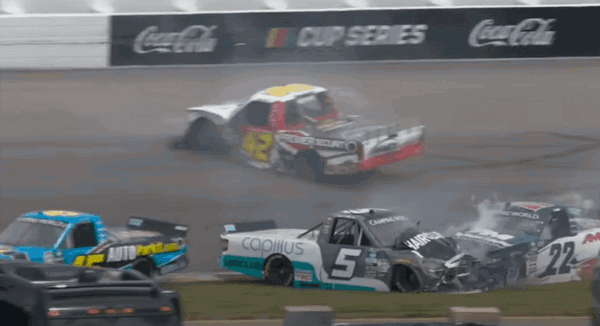

“Too soon” – that’s what springs to mind when you hear about the blink-and-you-miss-it NASCAR career that spanned a mere three minutes. In a world where some drivers seem to have racing in their blood, sticking around forever like Kevin Harvick, Dale Earnhardt Sr, Morgan Shepard, James Hylton, or the legendary Richard Petty, who each clocked multiple decades on the track, it’s a stark contrast. Most of today’s NASCAR drivers have a good 10 to 15 years under their belts, with a few here and there calling it quits after just a handful of seasons, or sometimes only a few races. And then there are those unicorns who appear for just one race.
But Billy Keyes, wheeling for the BnB Racing team, takes the cake. His race, and consequently his entire NASCAR stint, lasted all of three minutes! No other driver has had the checkered flag waved in their career that quickly. So, what’s the story behind this lightning-fast exit?
ADVERTISEMENT
Article continues below this ad
Billy Keyes’s three-minute dash in the world of racing is quite a tale
BnB Racing, kick-started in 2009 by Maria and Paul Bamburak with a second-hand Chevrolet from an unnamed truck team, eyed an opening in the truck series. With the series grappling with small fields, it was prime time for new part-time teams like BnB to jump in. Their first and only shot for the season was at the tenth race at Memphis Motorsports Park, with Paul at the helm. But without a qualifying lap and zero owner points, their debut fizzled out before it even started.
Poll of the day
Poll 1 of 5
AD
Fast forward to 2011, at the Martinsville practice session, Billy Keyes took to the track. In his first lap, as he was letting trucks pass in the first turn, disaster struck the #34 truck. The brakes locked, sending his truck careening sideways into the inside wall, taking Joey Coulter’s No. 22 truck with it. Both trucks were wrecked beyond repair. Keyes hadn’t even completed a full lap before his dream and his truck was in tatters. The front and rear frames of the truck were toast, and with that, Keyes’ NASCAR hopes evaporated in just three minutes.
Keyes later told Bleacher Report, “This weekend was a big one. If we did well, we’d be able to run more races. I’m frustrated. We worked so hard countless nights, all my family pitching in to help. Nobody wrecks in practice, that happens in the race but it happened to us.”
With no backup truck, the No. 34 team had to pack up and leave. Keyes reflected on the ordeal, telling Bleacher Report about the tough lesson learned: “Double-check everything and make sure everything is right.” With their truck a write-off, BnB Racing shut its doors. Keyes went back to late-model circuit racing, never to grace a NASCAR track again.
Watch This Story: Tony Stewart’s Insider Claims to Mimic Rick Hendrick’s Blueprint for Success
ADVERTISEMENT
Article continues below this ad
Keeping Keyes’ short-lived stint as an exception, it’s a known fact that NASCAR drivers generally have lengthier careers; even longer than their F1 counterparts, often blessed with more time behind the wheel.
Top Stories
Why do NASCAR drivers tend to have longer runs in their careers compared to other motorsports, especially F1?
A big part of it boils down to the demands of the vehicles they’re piloting. Driving an F1 car is like a full-body workout – it’s incredibly taxing, especially on the neck and back. Just look at the 2023 Qatar GP for a clear picture; it’s a grueling marathon for the whole body. In NASCAR, drivers typically hit their stride around 30 or in their mid-30s. So, when they decide to hang up their helmets, they’re often in their early to mid-40s. In contrast, F1 drivers usually peak in their mid-20s and start taking their final bows in their mid to late 30s.
ADVERTISEMENT
Article continues below this ad
Read More: NASCAR News: Jimmie Johnson Reacts as Wife Chandra Complements His Hall of Fame Induction Ceremony
Over the past 15 years, NASCAR has seen a shift in driver demographics. The age at which drivers used to retire, around 38, has dropped to about 33. This change is partly due to fewer drivers sticking around past their early 30s. As a result, big names like Kevin Harvick, Jeff Gordon, Tony Stewart, and Carl Edwards have bowed out earlier than expected. Another factor could be the surge of young, speedy drivers vying for the winner’s circle, shaking up the status quo.
ADVERTISEMENT
ADVERTISEMENT
ADVERTISEMENT
ADVERTISEMENT

